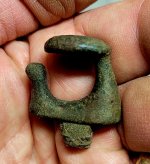Found this to be the best I've seen explaining how lode gold is deposited. 15 minutes
Found at Metal Mines of Josephine County Oregon Facebook site
https://www.facebook.com/Metal-Mines-of-Josephine-County-Oregon-361405923991772/
Found at Metal Mines of Josephine County Oregon Facebook site
https://www.facebook.com/Metal-Mines-of-Josephine-County-Oregon-361405923991772/
Amazon Forum Fav 👍
Last edited:
Upvote
0



